Click on images to enlarge
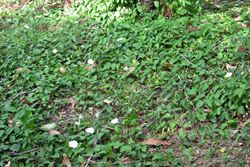
infestation (Photo: Chris Gardiner)

creeping habit (Photo: Chris Gardiner)
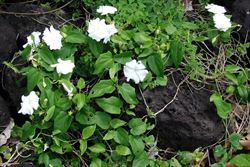
climbing habit (Photo: Forest and Kim Starr, USGS)
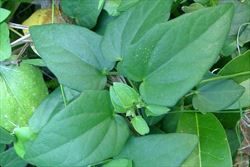
leaves (Photo: Sheldon Navie)
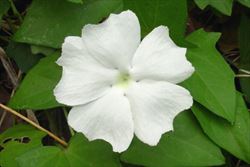
white flower with five spreading petal lobes (Photo: Chris Gardiner)

tubular flower from side-on with a pair of leafy bracts at the base (Photo: Sheldon Navie)

close-up of flower (Photo: Forest and Kim Starr, USGS)

immature fruit with a round base and elongated beak (Photo: Sheldon Navie)
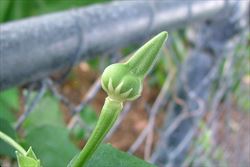
close-up of immature fruit with small persistent sepals (Photo: Sheldon Navie)
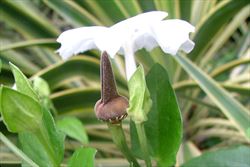
mature fruit (Photo: Sheldon Navie)

close-up of seeds (Photo: Tracey Slotta at USDA PLANTS Database)

seedling (Photo: Sheldon Navie)
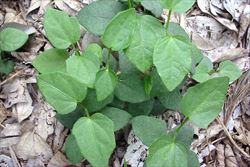
young plants (Photo: Sheldon Navie)
Scientific Name
Thunbergia fragrans Roxb.
Family
Acanthaceae
Common Names
angel wings, angelwings, fragrant thunbergia, sweet clock vine, sweet clock-vine, sweet clockvine, thunbergia, white clockvine, white lady, white thunbergia, whitelady
Origin
Native to the Indian Sub-continent (i.e. Bhutan, India, Nepal and Sri Lanka), south-eastern Asia (i.e. Myanmar, Cambodia and Vietnam) and China.
Cultivation
Fragrant thunbergia (Thunbergia fragrans) is widely cultivated in tropical and sub-tropical regions for its attractive white flowers.
Naturalised Distribution
This species has recently been recorded at several locations in the coastal districts of eastern Queensland.
Naturalised overseas in south-eastern USA (i.e. Florida), the Caribbean (e.g. Puerto Rico and the Virgin Islands), the Mascarenes (i.e. Mauritius and La Réunion) and on several Pacific islands (e.g. the Cook Islands, Fiji, French Polynesia, Hawaii, Niue, Western Samoa, Vanuata and Tonga).
Habitat
A potential weed of closed forests, forest margins, watercourses (i.e. riparian areas), urban bushland, disturbed sites, roadsides and plantation crops in tropical and sub-tropical regions.
Habit
A low-growing, slender-stemmed, spreading creeper or climbing vine.
Distinguishing Features
- a vine or creeper with slender four-angled stems that are somewhat hairy when young.
- its oppositely arranged leaves (4-10 cm long and 3-5 cm wide) have arrow-shaped bases and slightly lobed to almost entire margins.
- its white tubular flowers (about 5 cm across) are subtended by two leafy bracts (13-15 mm long).
- these flowers have a narrow tube and have five broad petal lobes.
- its distinctive fruit capsule is topped with a long, thick, beak.
Stems and Leaves
The slender, green or reddish coloured stems are square in cross-section (i.e. quadrangular) and somewhat hairy (i.e. pubescent) when young.
These stems bear pairs of oppositely arranged leaves that have stalks (i.e. petioles) about 4 cm long. Leaf blades (4-12 cm long and 3-5 cm wide) are egg-shaped in outline (i.e. ovate) or somewhat triangular with arrow-shaped (i.e. hastate) bases. They have margins that vary from being slightly lobed, to toothed (i.e. crenate), or almost entire (i.e. sub-entire).
Flowers and Fruit
The white, tubular flowers (4-6 cm across) are borne singly or in pairs on stalks (i.e. peduncles) emanating from the leaf forks (i.e. axils). Each flower is subtended by two leafy bracts (13-15 mm long) that are either egg-shaped in outline (i.e. ovate) or somewhat elongated (i.e. lanceolate) in shape. The flower tube is narrow (15-30 mm long) and topped with five broad, white, petal lobes (i.e. corolla lobes). Flowering occurs throughout the year, but mostly during summer and autumn.
The fruit is an almost-rounded (i.e. sub-globose) capsule topped with a long, thick, beak (up to 2 cm long).
Reproduction and Dispersal
This species reproduces by seeds and also vegetatively via fragments of stems and roots.
Dispersal of this species is usually facilitated by it being grown in gardens (i.e. as an ornamental), with stem fragments and seeds subsequently being spread in dumped garden waste.
Environmental Impact
Fragrant thunbergia (Thunbergia fragrans) is regarded as a potentially significant environmental weed in Queensland.
Legislation
This species is declared under legislation in the following states and territories:
- Queensland: Class 1 - introduction into the state is prohibited, and landowners must take reasonable steps to keep land free of this species (throughout the entire state). It is also illegal to sell a declared plant or its seed in this state.
- Western Australia: Prohibited - on the prohibited species list and not permitted entry into the state.
Management
For information on the management of this species see the following resources:
- the Biosecurity Queensland Fact Sheet on thunbergia species, which is available online at http://www.dpi.qld.gov.au.
Similar Species
Fragrant thunbergia (Thunbergia fragrans) is relatively similar to blue trumpet vine (Thunbergia grandiflora), laurel clock vine (Thunbergia laurifolia) and black-eyed Susan (Thunbergia alata), and very similar to native thunbergia (Thunbergia arnhemica). These species can be distinguished by the following differences:
- fragrant thunbergia (Thunbergia fragrans) is a spreading creeper or climber bearing moderately large flowers (about 50 mm across). These flowers are entirely white in colour and have a very narrow throat.
- blue trumpet vine (Thunbergia grandiflora) and laurel clock vine (Thunbergia laurifolia) are climbers bearing very large flowers (60-80 mm across). These flowers are usually blue or purplish in colour (white in Thunbergia grandiflora 'Alba') with broad throats that are pale yellowish in colour.
- black-eyed Susan (Thunbergia alata) is a climber bearing relatively small flowers (25-40 mm across). These flowers are usually orange (white in Thunbergia alata 'Alba') with conspicuous blackish-coloured throats that are quite narrow.
- native thunbergia (Thunbergia arnhemica) is a spreading creeper or climber with moderately large flowers (about 50 mm across). These flowers are entirely white in colour and are bell-shaped with a relatively broad throat.

